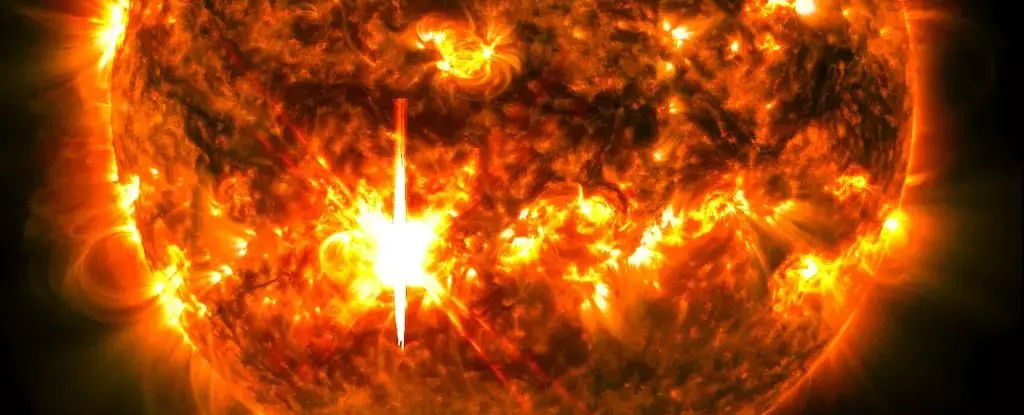The onset of October has not just marked the arrival of autumn but has heralded a striking display of solar activity that has captivated scientists and astronomy enthusiasts alike. On October 1, the Sun unleashed a powerful X7.1 solar flare, accompanied by a coronal mass ejection (CME), as it ramped up its activity in what is presumed to be a peak phase of its 11-year solar cycle. While the spectacle poses no immediate threat to life on Earth, the ensuing geomagnetic storms present an intriguing opportunity to observe the dynamic interactions between solar forces and our planet’s magnetic field.
Understanding Solar Flares and CMEs
Solar flares and CMEs are integral to understanding the Sun’s behavior, particularly during times of heightened activity. Solar flares are immense bursts of radiation resulting from the release of magnetic energy stored in the Sun’s atmosphere. The October 1 event, ranked as one of the most intense flares in the past three decades, serves as a vivid reminder of the Sun’s potential for dramatic eruptions. These events can disrupt radio communications on Earth – temporarily blinding the sunlit side of the planet to high-frequency radio signals.
Conversely, coronal mass ejections involve the expulsion of substantial amounts of solar plasma and magnetic fields from the Sun’s corona into space. When these charged particles collide with Earth’s magnetosphere, they create geomagnetic storms that can have varying effects, including the mesmerizing displays of the auroras borealis and australis. Though these phenomena are beautiful to witness, they also emphasize the critical relationship between solar activity and terrestrial phenomena.
The Role of Sunspots
Much of the Sun’s tumultuous behavior can be traced back to sunspots—temporary dark spots on the Sun’s surface that emerge due to intense magnetic activity. The sunspot region responsible for the recent flare, known as AR 3842, is particularly noteworthy due to its ‘Beta-Gamma-Delta’ classification. This classification indicates a mixture of magnetic polarities that can result in complex interactions, leading to the potential for significant flares.
The emergence of additional M-class flares from this sunspot region—another burst following the major X7.1 flare—signifies that AR 3842 remains a potent source of solar upheaval. As more flares erupt, these magnetic structures may continue to provide a rich canvas for both scientists studying solar phenomena and sky-gazers waiting for spectacular light displays.
Despite the awe-inspiring nature of these solar events, their actual impact on Earth varies considerably based on multiple factors. While flares can cause rapid disruptions in communications, CMEs can instigate more prolonged effects, especially if they are directed toward Earth. The NOAA Space Weather Prediction Center has anticipated geomagnetic storms ranging from minor to strong over the first week of October, peaking on October 4 and 5.
The possibility of G3-level geomagnetic storms suggests that the upper atmosphere may experience disruptions, potentially illuminating the night sky with stunning auroras. As these solar particles are funneled toward the poles, they collide with atmospheric gases, generating vibrant colors that dance across the sky—a phenomenon that transcends simple standards of beauty and reaches into the realm of cosmic wonder.
As anticipation builds around the potential for auroras, the scientific community and amateur astronomers alike are eager to witness the results of this solar flurry. Historical data indicates that the solar cycle is a rhythmic dancer, undergoing phases of relative calm and intense activity. The major flare in May, identified as one of the most robust in this cycle, generated astonishing auroras across various regions of the globe, leaving spectators marveling at nature’s artistry.
Forecasts suggest that October may also yield similar displays. Utilizing tools such as the Kp Index—a scale that gauges geomagnetic activity—meteorologists and scientists can approximate the likelihood of auroras, with predictions indicating elevated levels for early October.
The Significance of Ongoing Research
While these events capture public attention, they also underscore the importance of ongoing research into solar physics. Understanding the mechanics behind solar flares and CMEs has critical implications not just for space weather prediction but also for safeguarding technology infrastructures that are vulnerable to such cosmic disturbances. As scientists continue their exploration of solar behavior, each flare presents an opportunity to learn more about the Sun’s intricate workings and its influence on Earth.
The eruption of the X7.1 flare and its accompanying CME exemplifies the vibrant and often unpredictable nature of our closest star. This October stands out not just as a season for Halloween and falling leaves, but as a reminder of the cosmic wonders that lie just beyond our atmosphere, waiting to be explored and appreciated by all.

